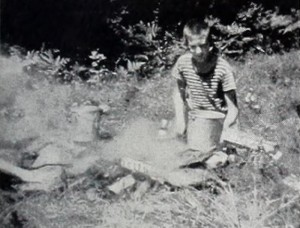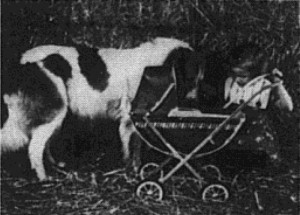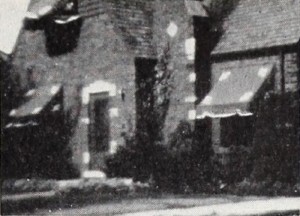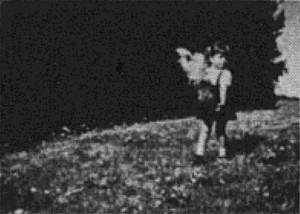"Various members of the Behrens family are seen walking out of the front door of a house. They are all wearing hats and coats and gather in groups on the driveway. There appears to be several generations of the family present. An elderly man and woman descend the front door steps, with a baby and two children. Concludes with everyone running around the driveway, larking about in front of the camera" (NWFA Online Database).
"Mr and Mrs Behrens are seen on a beach with two young children and a toddler. The three youngsters climb on top of a large pile of sand. The tide is out and the rest of the beach is deserted. Location Skerries" (NWFA Online Database).
"Various family scenes shot in the Behrens' garden at Holly Royde in Withington; May 1925. Includes a brief shot of a nanny playing with a baby and child on the lawn - two maids, carrying trays, are seen walking past in the background. Also features a family group - mum, dad, and two young children - exiting a garden gate and walking down a suburban street (The Beeches) in West Didsbury" (NWFA Online Database).
"Scenes of a Behrens family gathering. Various family members are filmed as they walk down a set of steps leading from the front door of a large house. They stand around talking to each other on the driveway. One of the men, holds hands with a young boy and they dance around in a circle" (NWFA Online Database).
"Members of the Behrens Family are seen enjoying a walking holiday in the Lake District. Includes various shots of the surrounding countryside - A couple of men are seen striding across a hillside towards the camera. They are wearing plus fours and carry walking sticks. Snow covers the ground they are walking on and one of the men attempts to throw a snowball at the camera. Concludes with a shot of three men, wearing overcoats and peaked caps, standing next to a parked car eating sandwiches" (NWFA Online Database).

"Excellent films have been made that show by more or less indirection what adults believe boys should do in camp. But what would boys like to do? Henry E. Hird, in The Big Adventure, seems almost to have thought with a boy's mind — a very real accomplishment for a busy executive — in producing this dramatic tale of boys in the woods. Two youngsters of about twelve years, armed with bows and arrows, are taken by their father on an island camping trip. Resigned, as most boys are under the instruction of their elders, they watch Father show them camp life in detail — and how he enjoys it! Suddenly he leaves for a war conference in Washington, and the two adventurers are alone for the night. A tramp appears, captures them, is outwitted by them and is seized by a helpful farmer. To bed and fears of invading bears go our heroes — when Dad returns, the conference deferred. It is a safe bet that young boys will approve Mr. Hird's dramatic movie as more realistic than some of the "approved solutions" offered to youthful campers." Movie Makers, Dec. 1945, 496.

"A most pleasant day with a little girl, her four kittens, and collie dog. The kittens do so many things that set them apart from other animals. They seem to enjoy their various playful activies before the flood lights and camera. While all this is going on, the collie feels just a little bit left out of things. Finally, all return to the barn for some fresh milk and a good night" PSA Journal, Nov. 1960, 39.
"Scenes at Billinge Scar (near Blackburn), the Birtwistle family home, including some rather dark interior shots" (NWFA Online Database).

"A brief film designed as a trailer for home use rarely possesses the quality of general audience appeal. Grace Lindner may be justly proud of having achieved this elusive element in Bless This House. The film is a hymn of love, an ode in praise of home, the family, mutual understanding and other ingredients of the good life. That the theme is an emotional one is admitted. That it might have become painfully saccharine is granted. That it did not is due to the sensitive and restrained manner in which the filmer has presented her familiar scenes. Fred Waring's recording of the title song furnished the theme and is used as an integral part of the film." Movie Makers, Dec. 1950, 466.

"Mother puts a blue case on the mantel. Baby daughter takes the case and goes for wild flowers. The case suffers an accident and small fry seeks the piggy bank for money to buy another. She goes to the ceramic plant but there is no vase. The nice man agrees to make one and we may watch as he does this. When completed, he takes only a small coin in payment. A simple, but beautiful family motion picture" PSA Journal, Nov. 1960, 41.
Total Pages: 15